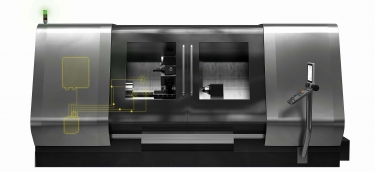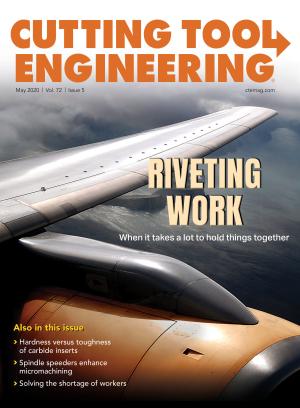To predict, detect and react to problems with machining processes within milliseconds, Sandvik Coromant Co., Fair Lawn, New Jersey, developed CoroPlus ProcessControl. At the same time, the monitoring system can collect data to correct and improve inefficiencies in a process.
“The main functionality is it automates data collection and analysis,” said Jeff Rizzie, director of digital machining. “It gathers the data directly from the machine tool and basically makes a decision on whether your machining process is stable or needs to be adjusted.”
A collision detection function determines when a machine has a collision and then quickly shuts down the machine. The function is not application-dependent. If a crash occurs, traditionally a machinist hits the stop button. But by the time that is performed manually, the damage is done, he said.

The CoroPlus ProcessControl process monitoring system is designed to increase machining security, such as on this universal turning center. Image courtesy of Sandvik Coromant
A tool guard function works similarly but in more finite terms. Rizzie said it looks for broken or missing tools and detects tool force overload to decide when a worn tool needs replacement. The function uses a combination of machine data, such as power and drive data, and data from a vibration sensor mounted on a spindle nose or turret.
“What we’re looking for are patterns or anomalies,” he said. “Like any kind of data analytics, we’re looking for those patterns that will tell us if everything is running properly or if there is a possible tool breakage situation.”
Data logging records profiles of tool behavior during machining, said Niels Bredick, senior solutions specialist of process control. Analyzing tools can extend their lifetimes. Using individualized sensor profiles and comparing them helps to better understand a problem with a process. Data can be used to replace a tool before something bad occurs, potentially saving thousands of dollars.
“Our equipment can be applied to any type of machine tool or robotic- or machine-type movement,” he said.
Bredick said the system increases tool life and reduces cycle times and scrap.
“What ProcessControl does is very, very powerful and provides tremendous value,” Rizzie said. “The real interesting part of ProcessControl is not what it does today but what it does in the future. What can we do with that data?”
The performance data the application gathers provides insight into how machines function as planned versus as optimized. He said the long-term objective is to build a knowledge base for engineers.
“You’re taking data, using it, collecting it and analyzing it for future use,” Rizzie said. “It can be used to find flaws in the process of using a tool as well. You can find areas of early chatter before you ever feel it.”
The size of the company, batches or components doesn’t matter, Bredick said. The customizable system can diminish damages, reduce downtime costs, provide process security and boost productivity.
For more information about Sandvik Coromant, call 201-794-5000 or visit www.sandvik.coromant.com.
Contact Details
Related Glossary Terms
- chatter
chatter
Condition of vibration involving the machine, workpiece and cutting tool. Once this condition arises, it is often self-sustaining until the problem is corrected. Chatter can be identified when lines or grooves appear at regular intervals in the workpiece. These lines or grooves are caused by the teeth of the cutter as they vibrate in and out of the workpiece and their spacing depends on the frequency of vibration.
- process control
process control
Method of monitoring a process. Relates to electronic hardware and instrumentation used in automated process control. See in-process gaging, inspection; SPC, statistical process control.
- turning
turning
Workpiece is held in a chuck, mounted on a face plate or secured between centers and rotated while a cutting tool, normally a single-point tool, is fed into it along its periphery or across its end or face. Takes the form of straight turning (cutting along the periphery of the workpiece); taper turning (creating a taper); step turning (turning different-size diameters on the same work); chamfering (beveling an edge or shoulder); facing (cutting on an end); turning threads (usually external but can be internal); roughing (high-volume metal removal); and finishing (final light cuts). Performed on lathes, turning centers, chucking machines, automatic screw machines and similar machines.



